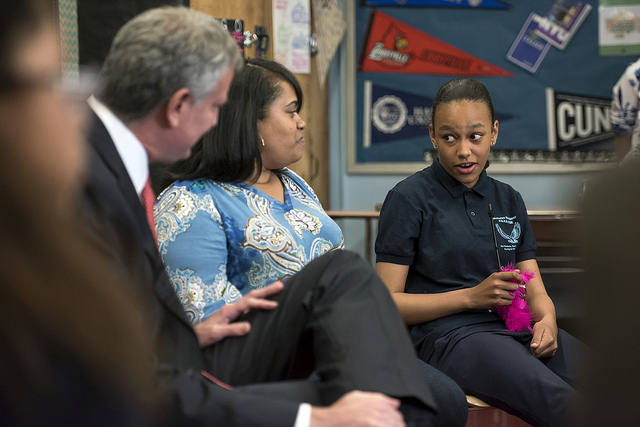
Mayor de Blasio in a restorative circle (photo: Ed Reed/Mayor’s Office)
There has been a great deal of celebration following passage of “Raise the Age,” legislation in New York that will end the practice of trying 16- and 17-year-old criminal defendants as adults. And rightfully so -- this will go a long way to dam the school-to-prison pipeline; we should be cheering. But rarely does a key strategy that helps students make better decisions and avoid arrest make headlines: restorative justice.
Like our justice system, our schools need to move away from overly punitive consequences and invest the resources to implement practices that address the root causes of misbehavior and set students on a path to long-term success.
Students need supports, not suspensions, to grapple with the larger problems that often lead to their misconduct. Students who have experienced trauma come to school carrying emotional baggage that impacts how they act in class. In low-income communities, such as the one I have served for six years, it is not uncommon for students to have suffered trauma from poverty, violence, and discrimination. I have a student who has bounced around foster families. Another student witnessed his dad get beaten by gang members. Relying on inflexible, insensitive, zero-tolerance discipline policies only compounds the mental, emotional, and academic damage from trauma and does not give students the tools to deal with challenges constructively and overcome them.
Even as New York has made a huge push to reduce suspensions, little has been done to support educators like myself to learn alternatives, such as restorative justice practices. Three years ago, I transitioned from my role as a math teacher to a dean. Teachers would send misbehaving students to my office, and I would hear their infraction, and unaware of alternatives, I would administer the punishment school protocol decided was appropriate. But after my first year, I knew detentions and suspensions were not having a long-term impact on student behavior. Unsure of a better way to handle discipline, I leaned on my abilities to foster relationships with students that I had honed as a teacher. As I began to see success with this approach, I sought out methods that leveraged relationships to improve behavior and stumbled on restorative practices.
The restorative approach to discipline is anathema to most educators’ training, and making the shift from punitive to restorative takes time, training, and buy-in.
Although my district offered little guidance, I knew I had to initiate this change for the sake of my students. In my free time I watched restorative justice videos on YouTube and attended external professional development. Transitioning from a punitive mindset, in which I evaluated a child’s misstep and doled out the commensurate consequence, to a restorative mindset, in which I sought to understand and address the cause of the misstep, was transformative. But it was also a difficult journey that could have been made easier with assistance from the district.
Now when students enter my office, they come in knowing we will have restorative conversations seeking to get to the root of the issue that brought them there. Students take responsibility for their actions and together we determine how to heal the situation.
An example of this was a recent fight between two high school students. Instead of suspensions, together they worked on a powerpoint on the perils of fighting and presented their findings to an eighth-grade group. Through this activity, the students learned from their mistakes, repaired the damage, and took responsibility to share their knowledge. That is the power of restorative justice; a suspension could never have achieved these outcomes. Interventions like these have reduced our suspensions by 55 percent. Imagine the difference if every school used restorative justice, and if the resources were there to help them do it.
But the beauty of restorative justice is not just the numbers, it’s the relationships. My teachers have seen the power of these relationships, and are taking it upon themselves to bring restorative justice to their classes. Now educators, and even student leaders, are spearheading restorative justice practices in my school. But they, and others around the state, need help. It’s time that New York build on it’s Raise the Age reforms by training our teachers in positive behavioral interventions that keep our kids in schools, not prisons.
***
Barry Price has been a math teacher, dean, and basketball coach for 11 years and is a member of Educators for Excellence-New York.
***
Have an op-ed idea or submission for Gotham Gazette? Email This email address is being protected from spambots. You need JavaScript enabled to view it.




